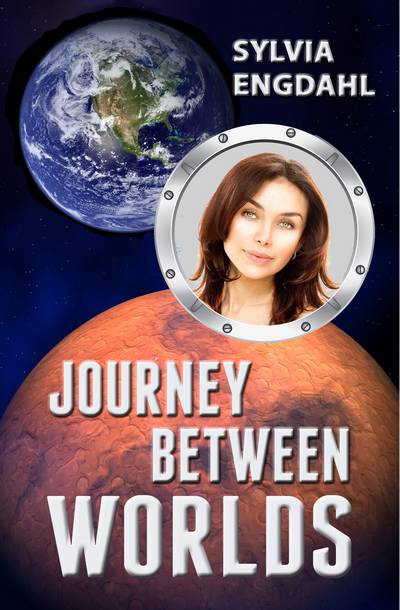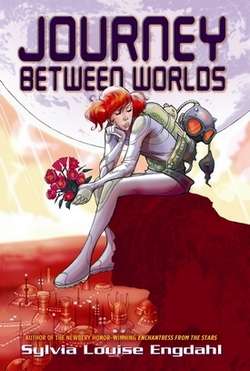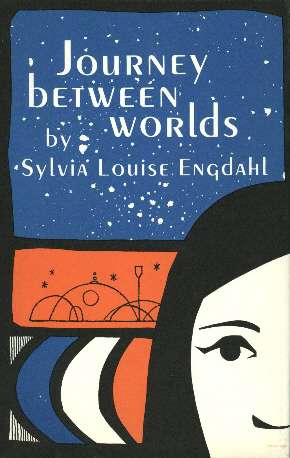
Journey Between Worlds
by Sylvia Engdahl
A YA romance novel for readers age 12 and older
Melinda Ashley has a plan for her life, and a trip to Mars isn't part of it. When she receives a spaceliner ticket as a high school graduation gift from her dad, she is dismayed, but reluctantly agrees to go with him--in part because she's infuriated by her fiance's high-handed declaration that she can't. Her outlook begins to change when she meets Alex Preston, a second-generation Martian colonist who is going home after college on Earth. Alex believes settling Mars is important. He's looking forward to the role he expects to play in the colony's future. Melinda finds this hard to understand, yet she is more and more drawn to him and, while on Mars, to his family. Torn between what she has always wanted and upsetting new feelings, she wonders if she can ever again be content. It takes tragedy and a terrifying experience on thr moon Phobos to make her aware of what really matters to her.
|
"A beautifully-written, heartwarming, and scientifically plausible novel." Orson Scott Card's Intergalactic Medicine Show
|
"A thought-provoking read... Will give readers much to ponder long after they've finished reading." Teens Read Too
|
"A fun read for younger audiences and an inspiring, hopeful and entertaining tale for older readers as well."
ScifiDimensions
|
Although this novel is set on Mars, it's not about technology or exotic adventure. It's usually enjoyed more by readers who like romance than by avid science fiction fans. It was first published by Atheneum in 1970 and a new hardcover edition was published in 2006 by Putnam, with revision to update descriptions of Mars and references to computer technology as well as to remove assumptions and phrasing that would strike today's readers as sexist. A few similar modifications have been added to the current edition. The action of the story hasn't been changed,
Purchase the ebook edition for $2.99 from
Amazon,
Amazon UK,
Barnes & Noble,
Apple Books,
Kobo,
Smashwords, or
Google Play.
Publication History
Atheneum (hc) - 1970
Putnam (hc, updated) - 2006
Firebird (pb) - 2007
Ad Stellae (eb) - 2015
Ad Stellae (pb) - 2018
Ad Stellae (audio) - 2024
Purchase the paperback and/or audiobook edition from Amazon. (The print version can be ordered from other booksellers but at a higher price due to distribution costs.)
Read the author's comments on some reactions to the book.
See more quotes from reviews.
Read an excerpt from the story.
Frequently Asked Questions

Putnam (2006) and Firebird (2007) editions
Journey Between Worlds is not at all like your other books. How did you come to write such a different one?
Actually, I wrote
Journey Between Worlds first, though it wasn't published until after
Enchantress from the Stars. It was a story I had wanted to write for many years and I'd been working on similar ones from time to time ever since I was in college. I believed, and still believe, that it was very important for young women to realize that space isn't just a place for adventure and violent action such as battles, which was the reputation space fiction had in the 1950s and early 60s. It's place where ordinary people will someday live.
Do you wish that it had been published first?
In a way, yes, because many people who liked
Enchantress from the Stars expected something similar and were disappointed, They felt it wasn't as good as
Enchantress. But the two books would have been compared anyway, and they really can't be because they aren't the same style and they appeal to different readers. An author is not obliged to direct all her work to the same audience. Most people who admire
Enchantress enjoy fantasy, and there's no suggestion of fantasy anywhere in
Journey. For this reason, readers who prefer realistic stories often think it's better. They are interested in the real future.
But on the whole, science fiction fans don't like it as well as your others. They find it hard to sympathize with a heroine who doesn't want to go to Mars.
It wasn't meant for science fiction fans. It was meant for girls who enjoy romance novels. But its publishers insisted on marketing it as science fiction instead of with teen romances, and librarians put it on science fiction shelves, so it has never reached many of the readers for whom it was intended--despite the fact that the 2006 edition received enthusiastic praise from the romance review blogs to which it was sent. I have found this very frustrating.

Atheneum edition (1970)
The cover of the 2006 edition makes it look like a light romance.
Yes, the publisher used a cover designed to appeal to teen romance readers and then marketed it in a way that kept them from seeing it, yet gave a false impression of the story to readers interested what space colonization will be like. It's good artistically but suggests that it's a fantastic portrayal of Mars rather than a scientifically accurate one, so the book didn't reach many space enthusiasts either. As a result, despite an excellent review from the National Space Society, it never appears in lists of serious Mars fiction.
Was the book revised much when it was republished in 2006?
Not with respect to the parts about space travel and Mars. I wrote it in 1967, before the Apollo missions, yet there was very little to change except some details based on discoveries made by the Mars landers, plus the use of computers by the public (which I didn't even imagine in 1967, though I'd been a computer programmer for ten years). However, there was a lot of revision needed to eliminate assumptions and phrasing that are viewed as sexist today. Even to me, the 1970 edition seems very outdated in its portrayal of women's attitudes.
To many readers, Melinda still doesn't seem like a modern woman, Couldn't you have updated her attitudes a little more?
Her attitudes as portrayed in the revised edition aren't a matter of when the book was written--they are her individual personality. I couldn't have characterized her differently and still have a story--it's about how she matures and comes of age, after all. If she started out with the same goals as a "modern" woman there wouldn't have been any plot conflict.

2015 edition
It's true that some readers don't identify with her, but there are others who do. One blogger wrote,
"I loved Melinda's voice--it was fresh and original and genuine.... I found it easy to relate to her." Another wrote,
"Readers are instantly drawn to Melinda, who is portrayed realistically ... we can all sympathize with her." Probably these particular reivewers and others who made similar comments are not themselves "modern women" in the eyes of the average space enthusiast, and that's just the point. The story was intended arouse interest in the future on the part of readers who aren't already looking forward to it.
There is another aspect to this. Hopefully, at least a few readers grasped the symbolism in the book that the majority seem to have missed. Melinda initially clings to what previous generations considered normal and natural, what she has always believed she wants, and sees no need to move beyond the confines of her past experience. So too do most people today cling to the idea that confinement to Earth is “natural” and see no necessity for the human race to go beyond the limits of the world where our ancestors evolved. But this outlook needs to change. That's the theme underlying the story, and it depends on my characterization of the heroine.
Do you think the book has been at all successful in opening people's minds to the importance of space colonization?
I have no way of knowing, but I suspect it hasn't been widely enough read to have much impact. I've been elated, though, by isolated incidents, such as when, many years ago, a librarian approached me at a meeting and told me it convinced her that the space program is worthwhile.



